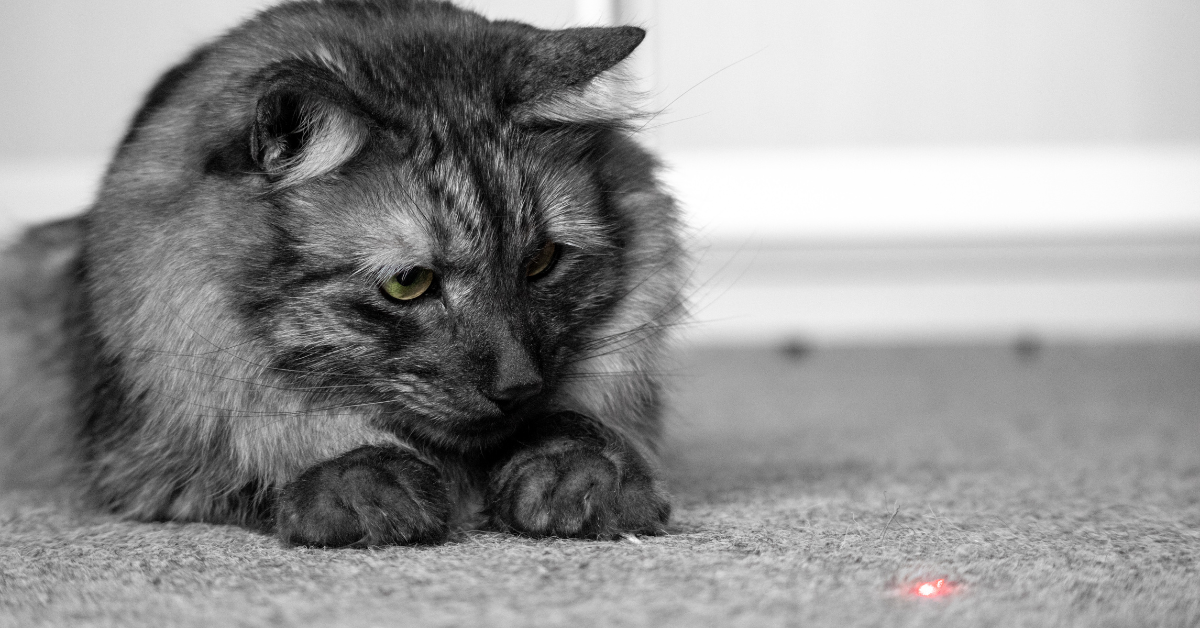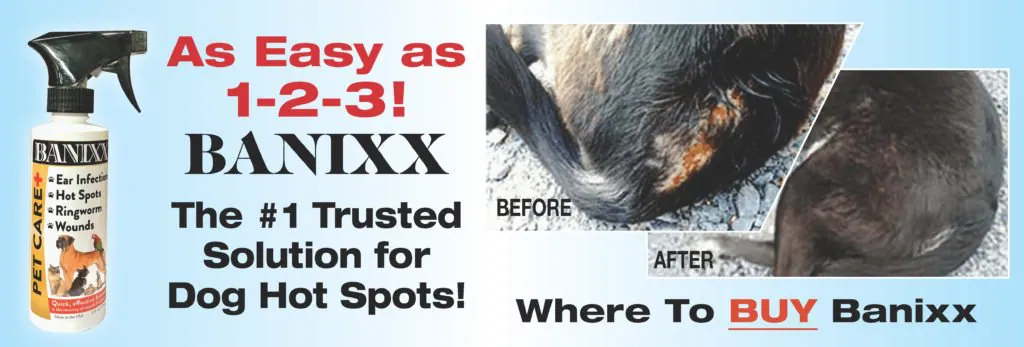There he goes again with that annoying habit. Your dog is biting and chewing on his nails again! While such behavior is commonly thought of as an annoyingly bad habit in humans, our dogs can be voracious nail biters too! But why? And should you be concerned?
As with other stressful situations that affect our dogs, this one may also have a simple solution. Or it may be more concerning and harder to cure. Here are some common causes for dogs that excessively bite and chew their nails. Most of which can be safely and quickly dealt with at home. But don’t let your guard down too soon. Some of the potential causes may require a trip to your vet for medication and/or a more complicated course of treatment or behavior modification. Let’s look at the possibilities.
Dog Biting Nails Prevention
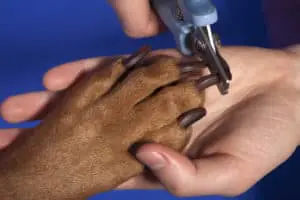
Prevent your dog’s nails from growing too long or falling into disrepair.
Stick to a regular grooming schedule to prevent your dog’s nails from growing too long or falling into disrepair. Fido’s nails grow relatively fast and can start to curve inward towards his paws. Excessively long nails are uncomfortable and even painful for your pooch, especially when they are running or walking. They may also unintentionally scratch you or one of the kids during playtime, which no one wants, especially Fido. Being smart and eager to please, you may see your dog trying to remedy the situation himself by instinctively biting at the nails to shorten them. Or, he may also start to paw aggressively at the ground to grind or wear the nails down.
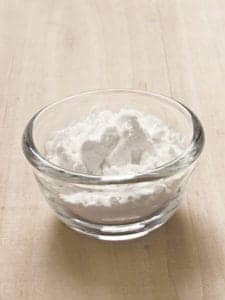
To stop the dog nail bleeding, immediately apply a pinch of Styptic powder or corn starch to your dog’s bleeding nail.
Many owners are comfortable trimming their dog’s nails themselves; although I always found this to be a little daunting! According to the American Kennel Club (AKC), a dog’s nail consists of a hard, outer surface called the shell and the living, pink inner material called the “quick.” The quick supplies blood to the nail and, if cut, can result in bleeding and pain to your pooch. If you decide to trim your dog’s nails you will need a supply of Styptic powder or a styptic pencil. These are made and sold for dogs and are available at any pet food store. Alternatively, have something as simple as corn starch on hand. If you trim too far, you will draw blood.
If this happens, to stop the dog nail bleeding, immediately apply a pinch of Styptic powder or corn starch to your dog’s bleeding nail. Continue to treat this way until the blood flow slows considerably, or stops. Or, if you use the styptic pencil, merely press it against the bleeding cut area to stop the bleeding. Whichever you use, it generally works very quickly. A normally healthy dog will not bleed to death when that vein inside their nails is cut or broken. It can be quite intense when the blood does start to flow, but a normal, healthy animal will have the proper coagulation that will stop the flow in due course.
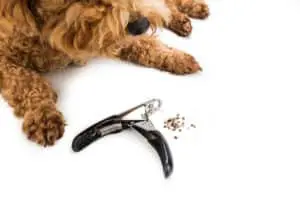
Keep dog nail trimming a pleasant experience.
Interestingly, regular nail trimming will result in the “quick” receding from the end, making nail trimming a much easier job and a much happier pup. But be careful, too many cuts into the “quick” will make Fido fear the nail trimming process and become tough to handle. Since nail trimming is a life-long routine for many dogs, it’s a great idea to make it and keep it a pleasant experience.
The other alternative is to use the expertise of a professional groomer to trim your dog’s nails. While some groomers may still prefer to cut the nails, many have switched to grinding the nails down. The grinding process slowly sands down the nail, while at the same time cauterizing the end. Either way, you should be assured that your pooch is in the capable hands of an experienced professional.
Broken Nails – Occasional or Frequent? It Could Be Important
Broken nails are no less irritating to dogs than humans. While we might just clip away jagged remnants of our broken nails, our furry friends will attempt to bite away their broken nails. Not only may this condition cause significant pain to your dog, but, the bacteria in your dog’s mouth can lead to an ugly infection or a hot spot. If you can see that your dog is compulsive chewing on a broken nail use clippers to remove the broken portion of the nail. Another option is a trip to your vet or to your groomer. This may be an excellent time to start the topical application of an antibacterial/anti-fungal solution such as Banixx Pet Care. This will help to soothe the irritation and stop the infection in its tracks.
Symmetrical Lupoid Onychodystrophy
If you notice that your dog seems to be suffering from broken nails on a more regular basis, he may have a condition known as Symmetrical Lupoid Onychodystrophy (SLO). SLO is an autoimmune condition that causes their bodies to attack the nails. This condition can drive Fido crazy, and he will undoubtedly respond by obsessively biting and pulling at his nails. If this occurs, waste no time in taking your pup to a trusted veterinarian. He/she will be able to quickly diagnose the problem and start an effective medication regiment to get the condition under control.
Dog Chewing Nails Due To Itchy Skin/Allergies
Just like their humans, dogs can also experience allergies to many things, including food, parasites, flea bites, outdoor allergens, etc. If your dog is neurotically biting or chewing at his nails, it could mean that he has been in contact with some sort of outdoor allergen. Examples are grass, pollen, or chemical lawn treatments that have subsequently attached to your dog’s nails. An allergy to flea bites or other parasites may also be the culprits to Fido’s torture. To free himself from this acute irritation, your dog may appear to be fixedly chewing at his nails, but, in actual fact, he’s aiming at the itchy skin in between his toes and his paws. Dogs can chew so much that they break open the skin, which can, in turn, lead to infection or a raging hot spot.
Solutions to your dog’s allergies may be time-consuming and complicated to find. Discovering the root cause may mean a trip to your vet for parasites or allergy testing. Temporarily soothing your dog’s itchy toes/skin may be your only immediate option while you explore all avenues for the cause. Two excellent product choices that may relieve your dog’s itchiness, while searching for the origin of his allergies, are Banixx Pet Care Spray and Banixx Medicated Shampoo.
Remember, allergies are systemic (internal) and generally develop over time, so will require significant time and effort in to resolve. While this discovery is in process, daily applications of Banixx can help provide an immediate and calming respite for your dog until the real culprit can be determined.
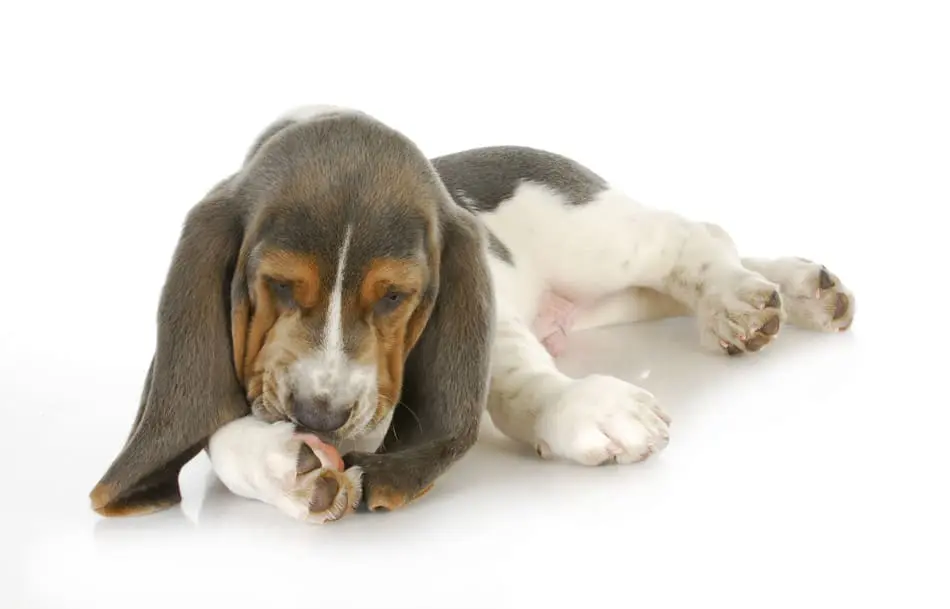
An fungal or bacterial infection may the reason your dog keeps gnawing at his nails.
Bacterial or Fungal Infections
An infection may be another reason your dog keeps gnawing at his nails. Infections can begin from a fungal infection in your dog’s nail bed. It could also be a bacterial infection caused by an exposed, untreated wound from a broken/torn nail, or paw injury. Infections may develop into itchy skin that your dog will continuously chew, lick, bite, or scratch to relieve. This may damage the skin even further. Infections can lead to raging hot spots. It’s crucial to determine the underlying cause, as soon as possible. If you notice Fido fixating and chewing at his nails and/or paws, check the area for signs of matted hair/fur, as well as any red, swollen, oozing sores. Caught in the early stages, Banixx may be all that is needed but watch! These infections can run rampant and may need antibiotics, which means a trip to your vet.
Anxiety and/or Boredom
When you think of an anxious dog, think of stress. Humans often chew their nails when they become overly stressed. The same is often the case for our furry friends. For example, thunderstorms, fireworks, and separation anxiety – some dogs become too stressed when left home alone. These are just a few everyday situations that may trigger stress-induced anxiety in our dogs. Any anxiety can result in stress-induced nail-biting behavior in your dog. If you think that your dog suffers from anxiety, especially separation anxiety, a trip to your vet, or an animal behaviorist/trainer, may help to get answers.
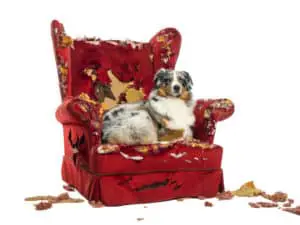
Distract your dog to keep them from chewing their nails and furniture.
Boredom, on the other hand, is an issue of a lack of stimulation rather than one of stress. Does your dog turn into Houdini or a kleptomaniac when left home alone? Destructive behavior is often indicative of a bored dog. But, there are many other undesirable, destructive behaviors. Examples are, stealing articles of their human’s clothing, trying to escape the house or yard, and the ever-annoying habit of chewing of your favorite purses, shoes, furniture, pillows, or rugs.
One little word that will do wonders with boredom issues – DISTRACT, DISTRACT, DISTRACT. Make sure your dog has plenty of toys, ropes, or safe chews to re-direct his nervous energy while you’re gone. Try taking him on a nice walk or run around the yard before you leave. The goal is to tire him sufficiently so that he will snooze during your absence rather than learning the nasty habits such as chewing his nails.
In Conclusion
There are many reasons why your furry companion is obsessively biting or chewing at his nails. Some are relatively benign, and some may lead to severe medical or behavioral conditions that will require professional intervention.
Through it all, however, for immediate topical relief of Fido’s symptoms, consider a strong infection fighter like Banixx Pet Care. Banixx is not a dog medicine. Its powerful combination of low acidity and high oxygen levels are ideal for faster wound healing. It merely creates an environment that is totally inhospitable to bacteria and fungi. Thus, the immune system can spend more time healing the injured tissue rather than expending excessive energy fighting infections.
We hope you found this article helpful and if your dog ever gets any cuts, abrasions, ear infections or hot spots, we hope you keep Banixx Pet Care in mind. Go to our dog page to learn more about how to keep your dog happy and healthy! Just as an example, do you know how long your dog can go without peeing? or Why your dog drinks out of your toilet?
Share this Post
Featured Post
Recent Posts
Lipomas….mysterious Lumps & Bumps on your pup…When should I worry? What should I do about them?
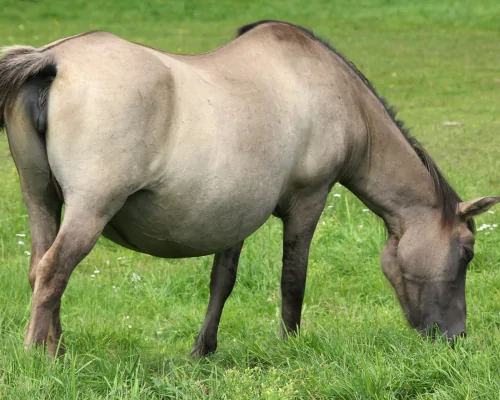
Managing the Mamas –Part 2 –The development process
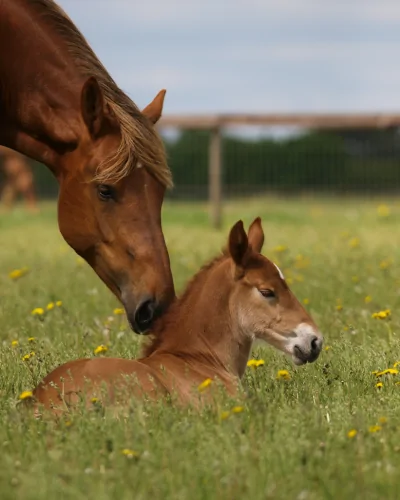
Managing the Mamas: Part 1 – Preparing to Breed Your Mare

HOW MANY TOES?? Caring for the Polydactyl Cat
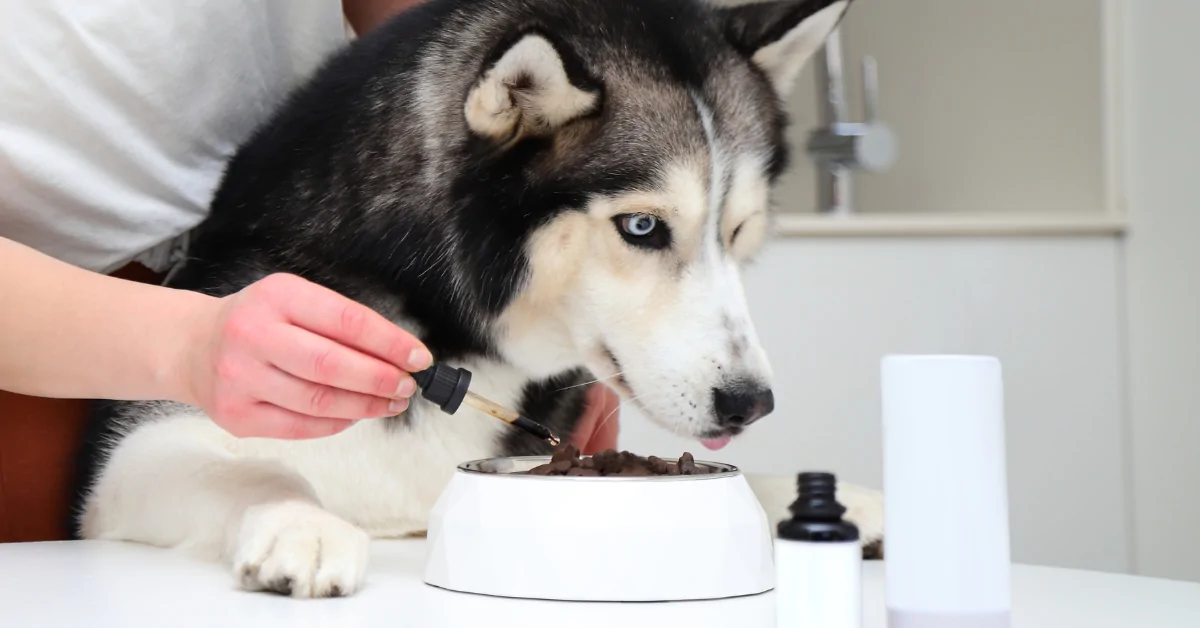
Do Dog Joint Supplements Actually Work?
